Identification of Elastoplastic Constitutive Model of GaN Thin Films Using Instrumented Nanoindentation and Machine Learning Technique
Abstract
1. Introduction
2. Materials and Nanoindentation Experiments
2.1. Growth Process
2.2. Nanoindentation Experiments
3. Identification Methodology
3.1. Finite Element Modeling
3.2. Elastoplastic Constitutive Model
3.3. Data Sampling and Database Generation
3.4. Artificial Neural Network (ANN)
4. Results and Discussion
5. Conclusions
Author Contributions
Funding
Institutional Review Board Statement
Informed Consent Statement
Data Availability Statement
Conflicts of Interest
References
- Touré, A.; Halidou, I.; Benzarti, Z.; Fouzri, A.; Bchetnia, A.; El Jani, B. Characterization of Low Al Content AlxGa1−xN Epitaxial Films Grown by Atmospheric-Pressure MOVPE. Phys. Status Solidi 2012, 209, 977–983. [Google Scholar] [CrossRef]
- Benzarti, Z.; Khalfallah, A.; Bougrioua, Z.; Evaristo, M.; Cavaleiro, A. Understanding the Influence of Physical Properties on the Mechanical Characteristics of Mg-Doped GaN Thin Films. Mater. Chem. Phys. 2023, 307, 128182. [Google Scholar] [CrossRef]
- Benzarti, Z.; Sekrafi, T.; Bougrioua, Z.; Khalfallah, A.; El Jani, B. Effect of SiN Treatment on Optical Properties of InxGa1−xN/GaN MQW Blue LEDs. J. Electron. Mater. 2017, 46, 4312–4320. [Google Scholar] [CrossRef]
- Bayram, C.; Shiu, K.T.; Zhu, Y.; Cheng, C.W.; Sadana, D.K.; Teherani, F.H.; Rogers, D.J.; Sandana, V.E.; Bove, P.; Zhang, Y.; et al. Engineering Future Light Emitting Diodes and Photovoltaics with Inexpensive Materials: Integrating ZnO and Si into GaN-Based Devices. Oxide-Based Mater. Devices IV 2013, 8626, 86260L. [Google Scholar] [CrossRef]
- Prado, E.O.; Bolsi, P.C.; Sartori, H.C.; Pinheiro, J.R. An Overview about Si, Superjunction, SiC and GaN Power MOSFET Technologies in Power Electronics Applications. Energies 2022, 15, 5244. [Google Scholar] [CrossRef]
- Runton, D.W.; Trabert, B.; Shealy, J.B.; Vetury, R. History of GaN: High-Power RF Gallium Nitride (GaN) from Infancy to Manufacturable Process and Beyond. IEEE Microw. Mag. 2013, 14, 82–93. [Google Scholar] [CrossRef]
- Lin, J.T.; Wang, P.; Shuvra, P.; McNamara, S.; McCurdy, M.; Davidson, J.; Walsh, K.; Alles, M.; Alphenaar, B. Impact of X-ray Radiation on GaN/AlN MEMS Structure and GaN HEMT Gauge Factor Response. In Proceedings of the 2020 IEEE 33rd International Conference on Micro Electro Mechanical Systems (MEMS), Vancouver, BC, Canada, 18–22 January 2020; pp. 968–971. [Google Scholar] [CrossRef]
- Ambacher, O.; Eickhoff, M.; Link, A.; Hermann, M.; Stutzmann, M.; Bernardini, F.; Fiorentini, V.; Smorchkova, Y.; Speck, J.; Mishra, U.; et al. Electronics and Sensors Based on Pyroelectric AlGaN/GaN Heterostructures: Part A: Polarization and Pyroelectronics. Phys. Status Solidi C Conf. 2003, 1878–1907. [Google Scholar] [CrossRef]
- Lv, L.; Ma, J.G.; Cao, Y.R.; Zhang, J.C.; Zhang, W.; Li, L.; Xu, S.R.; Ma, X.H.; Ren, X.T.; Hao, Y. Study of Proton Irradiation Effects on AlGaN/GaN High Electron Mobility Transistors. Microelectron. Reliab. 2011, 51, 2168–2172. [Google Scholar] [CrossRef]
- Rocco, E.; Licata, O.; Mahaboob, I.; Hogan, K.; Tozier, S.; Meyers, V.; McEwen, B.; Novak, S.; Mazumder, B.; Reshchikov, M.; et al. Hillock Assisted P-Type Enhancement in N-Polar GaN:Mg Films Grown by MOCVD. Sci. Rep. 2020, 10, 1426. [Google Scholar] [CrossRef]
- Azimah, E.; Zainal, N.; Hassan, Z.; Shuhaimi, A.; Bahrin, A. Electrical and Optical Characterization of Mg Doping in GaN. Adv. Mater. Res. 2013, 620, 453–457. [Google Scholar]
- Boughrara, N.; Benzarti, Z.; Khalfallah, A.; Evaristo, M.; Cavaleiro, A. Comparative Study on the Nanomechanical Behavior and Physical Properties Influenced by the Epitaxial Growth Mechanisms of GaN Thin Films. Appl. Surf. Sci. 2022, 579, 152188. [Google Scholar] [CrossRef]
- Tsai, C.H.; Jian, S.R.; Juang, J.Y. Berkovich Nanoindentation and Deformation Mechanisms in GaN Thin Films. Appl. Surf. Sci. 2008, 254, 1997–2002. [Google Scholar] [CrossRef]
- Khalfallah, A.; Benzarti, Z. Mechanical Properties and Creep Behavior of Undoped and Mg-Doped GaN Thin Films Grown by Metal–Organic Chemical Vapor Deposition. Coatings 2023, 13, 1111. [Google Scholar] [CrossRef]
- Laxmikant Vajire, S.; Prashant Singh, A.; Kumar Saini, D.; Kumar Mukhopadhyay, A.; Singh, K.; Mishra, D. Novel Machine Learning-Based Prediction Approach for Nanoindentation Load-Deformation in a Thin Film: Applications to Electronic Industries. Comput. Ind. Eng. 2022, 174, 108824. [Google Scholar] [CrossRef]
- Peng, L.; Liu, F.; Ni, J.; Lai, X. Size Effects in Thin Sheet Metal Forming and Its Elastic–Plastic Constitutive Model. Mater. Des. 2007, 28, 1731–1736. [Google Scholar] [CrossRef]
- Raulea, L.V.; Goijaerts, A.M.; Govaert, L.E.; Baaijens, F.P.T. Size Effects in the Processing of Thin Metal Sheets. J. Mater. Process. Technol. 2001, 115, 44–48. [Google Scholar] [CrossRef]
- Pathak, S.; Kalidindi, S.R. Spherical Nanoindentation Stress-Strain Curves. Mater. Sci. Eng. R. Rep. 2015, 91, 1–36. [Google Scholar] [CrossRef]
- Golovin, Y.I. Nanoindentation and Mechanical Properties of Solids in Submicrovolumes, Thin near-Surface Layers, and Films: A Review. Phys. Solid State 2008, 50, 2205–2236. [Google Scholar] [CrossRef]
- Liu, K.; Ostadhassan, M.; Bubach, B. Applications of Nano-Indentation Methods to Estimate Nanoscale Mechanical Properties of Shale Reservoir Rocks. J. Nat. Gas Sci. Eng. 2016, 35, 1310–1319. [Google Scholar] [CrossRef]
- Boughrara, N.; Benzarti, Z.; Khalfallah, A.; Oliveira, J.C.; Evaristo, M.; Cavaleiro, A. Thickness-Dependent Physical and Nanomechanical Properties of AlxGa1−xN Thin Films. Mater. Sci. Semicond. Process. 2022, 151, 107023. [Google Scholar] [CrossRef]
- Jian, S.R.; Tasi, C.H.; Huang, S.Y.; Luo, C.W. Nanoindentation Pop-in Effects of Bi2Te3 Thermoelectric Thin Films. J. Alloys Compd. 2015, 622, 601–605. [Google Scholar] [CrossRef]
- Zhou, G.; Guo, J.; Zhao, J.; Tang, Q.; Hu, Z. Nanoindentation Properties of 18CrNiMo7-6 Steel after Carburizing and Quenching Determined by Continuous Stiffness Measurement Method. Metals 2020, 10, 125. [Google Scholar] [CrossRef]
- Ohmura, T.; Wakeda, M. Pop-In Phenomenon as a Fundamental Plasticity Probed by Nanoindentation Technique. Materials 2021, 14, 1879. [Google Scholar] [CrossRef]
- Qian, L.; Zhao, H. Nanoindentation of Soft Biological Materials. Micromachines 2018, 9, 654. [Google Scholar] [CrossRef]
- Li, Y.; Li, S. Deep Learning Based Phase Transformation Model for the Prediction of Microstructure and Mechanical Properties of Hot-Stamped Parts. Int. J. Mech. Sci. 2022, 220, 107134. [Google Scholar] [CrossRef]
- Sun, X.; Liu, Z.; Wang, X.; Chen, X. Determination of Ductile Fracture Properties of 16MND5 Steels under Varying Constraint Levels Using Machine Learning Methods. Int. J. Mech. Sci. 2022, 224, 107331. [Google Scholar] [CrossRef]
- Merayo, D.; Rodríguez-Prieto, A.; Camacho, A.M. Prediction of Mechanical Properties by Artificial Neural Networks to Characterize the Plastic Behavior of Aluminum Alloys. Materials 2020, 13, 5227. [Google Scholar] [CrossRef]
- Long, X.; Dong, R.; Su, Y.; Chang, C. Critical Review of Nanoindentation-Based Numerical Methods for Evaluating Elastoplastic Material Properties. Coatings 2023, 13, 1334. [Google Scholar] [CrossRef]
- Li, Z.; Ye, Y.; Zhang, G.; Guan, F.; Luo, J.; Wang, P.; Zhao, J.; Zhao, L. Research on Determining Elastic–Plastic Constitutive Parameters of Materials from Load Depth Curves Based on Nanoindentation Technology. Micromachines 2023, 14, 1051. [Google Scholar] [CrossRef]
- Smith, J.L. Advances in Neural Networks and Potential for Their Application to Steel Metallurgy. Mater. Sci. Technol. 2020, 36, 1805–1819. [Google Scholar] [CrossRef]
- Park, S.; Fonseca, J.H.; Marimuthu, K.P.; Jeong, C.; Lee, S.; Lee, H. Determination of Material Properties of Bulk Metallic Glass Using Nanoindentation and Artificial Neural Network. Intermetallics 2022, 144, 107492. [Google Scholar] [CrossRef]
- Lu, L.; Dao, M.; Kumar, P.; Ramamurty, U.; Karniadakis, G.E.; Suresh, S. Extraction of Mechanical Properties of Materials through Deep Learning from Instrumented Indentation. Proc. Natl. Acad. Sci. USA 2020, 117, 7052–7062. [Google Scholar] [CrossRef]
- Jeong, K.; Lee, H.; Kwon, O.M.; Jung, J.; Kwon, D.; Han, H.N. Prediction of Uniaxial Tensile Flow Using Finite Element-Based Indentation and Optimized Artificial Neural Networks. Mater. Des. 2020, 196, 109104. [Google Scholar] [CrossRef]
- Wang, J.S.; Zheng, X.J.; Zheng, H.; Song, S.T.; Zhu, Z. Identification of Elastic Parameters of Transversely Isotropic Thin Films by Combining Nanoindentation and FEM Analysis. Comput. Mater. Sci. 2010, 49, 378–385. [Google Scholar] [CrossRef]
- Cheng, S.W.; Chen, B.S.; Jian, S.R.; Hu, Y.M.; Le, P.H.; Tuyen, L.T.C.; Lee, J.W.; Juang, J.Y. Finite Element Analysis of Nanoindentation Responses in Bi2Se3 Thin Films. Coatings 2022, 12, 1554. [Google Scholar] [CrossRef]
- Shui, S. Progress and Challenges in Finite Element Simulation of Nanoindentation of Ion-Irradiated Materials. J. Phys. Conf. Ser. 2021, 1885, 032039. [Google Scholar] [CrossRef]
- Bressan, J.D.; Tramontin, A.; Rosa, C. Modeling of Nanoindentation of Bulk and Thin Film by Finite Element Method. Wear 2005, 258, 115–122. [Google Scholar] [CrossRef]
- Barkachary, B.M.; Joshi, S.N. Numerical Simulation and Experimental Validation of Nanoindentation of Silicon Using Finite Element Method. In Advances in Computational Methods in Manufacturing: Select Papers from ICCMM 2019; Springer: Singapore, 2019; pp. 861–875. [Google Scholar] [CrossRef]
- Keryvin, V.; Charleux, L.; Bernard, C.; Nivard, M. The Influence of Indenter Tip Imperfection and Deformability on Analysing Instrumented Indentation Tests at Shallow Depths of Penetration on Stiff and Hard Materials. Exp. Mech. 2017, 57, 1107–1113. [Google Scholar] [CrossRef]
- Shi, Z.; Feng, X.; Huang, Y.; Xiao, J.; Hwang, K.C. The Equivalent Axisymmetric Model for Berkovich Indenters in Power-Law Hardening Materials. Int. J. Plast. 2010, 26, 141–148. [Google Scholar] [CrossRef]
- Lee, H.; Huen, W.Y.; Vimonsatit, V.; Mendis, P. An Investigation of Nanomechanical Properties of Materials Using Nanoindentation and Artificial Neural Network. Sci. Rep. 2019, 9, 13189. [Google Scholar] [CrossRef]
- Ktari, Z.; Leitão, C.; Prates, P.A.; Khalfallah, A. Mechanical Design of Ring Tensile Specimen via Surrogate Modelling for Inverse Material Parameter Identification. Mech. Mater. 2021, 153, 103673. [Google Scholar] [CrossRef]
- Nino-Adan, I.; Portillo, E.; Landa-Torres, I.; Manjarres, D. Normalization Influence on ANN-Based Models Performance: A New Proposal for Features’ Contribution Analysis. IEEE Access 2021, 9, 125462–125477. [Google Scholar] [CrossRef]
- Huang, L.; Qin, J.; Zhou, Y.; Zhu, F.; Liu, L.; Shao, L. Normalization Techniques in Training DNNs: Methodology, Analysis and Application. IEEE Trans. Pattern Anal. Mach. Intell. 2023, 45, 10173–10196. [Google Scholar] [CrossRef] [PubMed]
- Burden, F.; Winkler, D. Bayesian Regularization of Neural Networks. In Methods in Molecular Biology; Livingstone, D.J., Ed.; Humana Press: Totowa, NJ, USA, 2008; Volume 458, pp. 23–42. ISBN 9781588297181. [Google Scholar]
- Mao, W.G.; Shen, Y.G.; Lu, C. Nanoscale Elastic-Plastic Deformation and Stress Distributions of the C Plane of Sapphire Single Crystal during Nanoindentation. J. Eur. Ceram. Soc. 2011, 31, 1865–1871. [Google Scholar] [CrossRef]
- Wang, T.H.; Fang, T.H.; Lin, Y.C. A Numerical Study of Factors Affecting the Characterization of Nanoindentation on Silicon. Mater. Sci. Eng. A 2007, 447, 244–253. [Google Scholar] [CrossRef]
- Ivashchenko, V.I.; Turchi, P.E.A.; Shevchenko, V.I. Simulations of the Mechanical Properties of Crystalline, Nanocrystalline, and Amorphous SiC and Si. Phys. Rev. B—Condens. Matter Mater. Phys. 2007, 75, 085209. [Google Scholar] [CrossRef]
- Schiøtz, J.; Vegge, T.; Di Tolla, F.D.; Jacobsen, K.W. Atomic-Scale Simulations of the Mechanical Deformation of Nanocrystalline Metals. Phys. Rev. B—Condens. Matter Mater. Phys. 1999, 60, 11971–11983. [Google Scholar] [CrossRef]
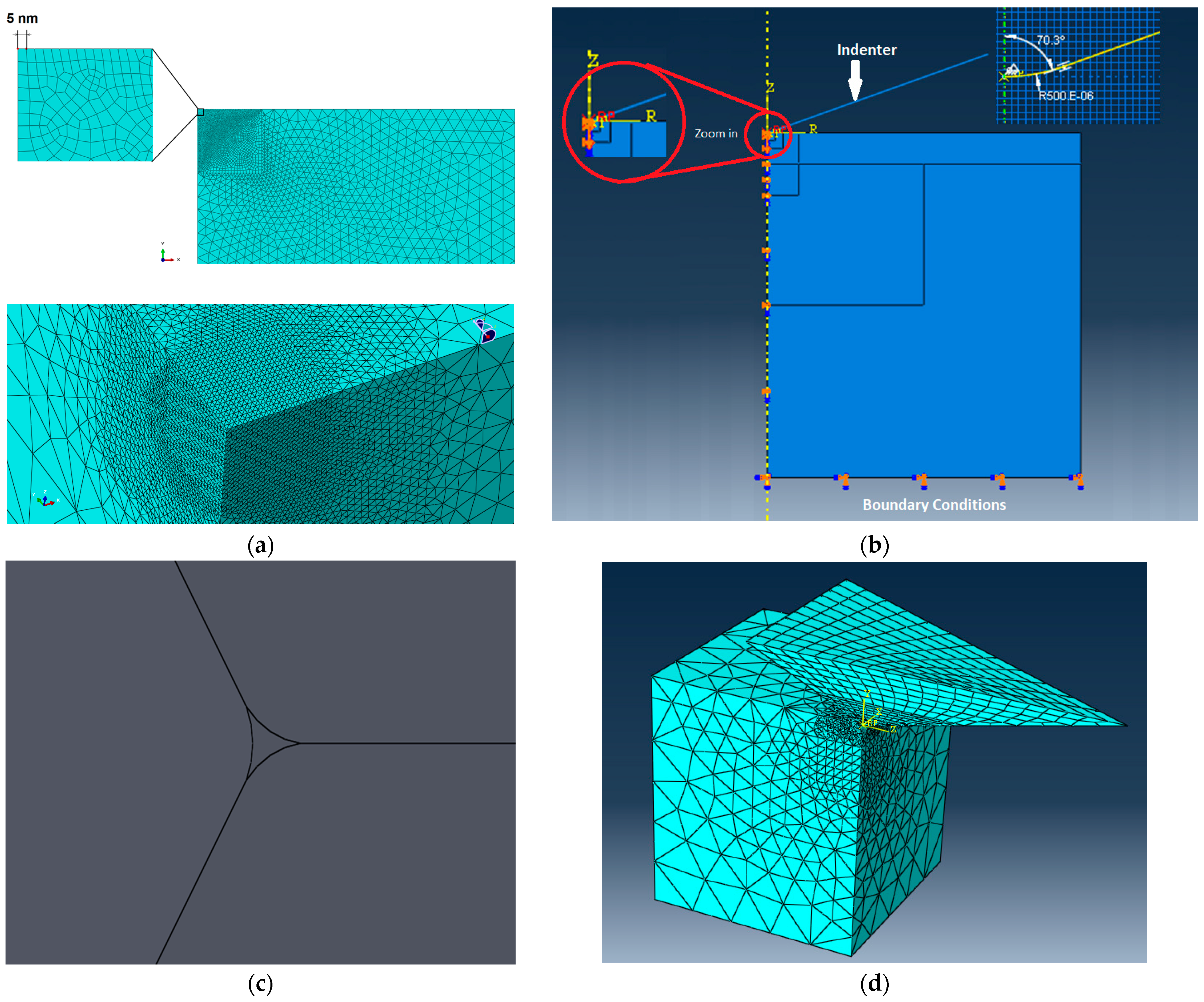
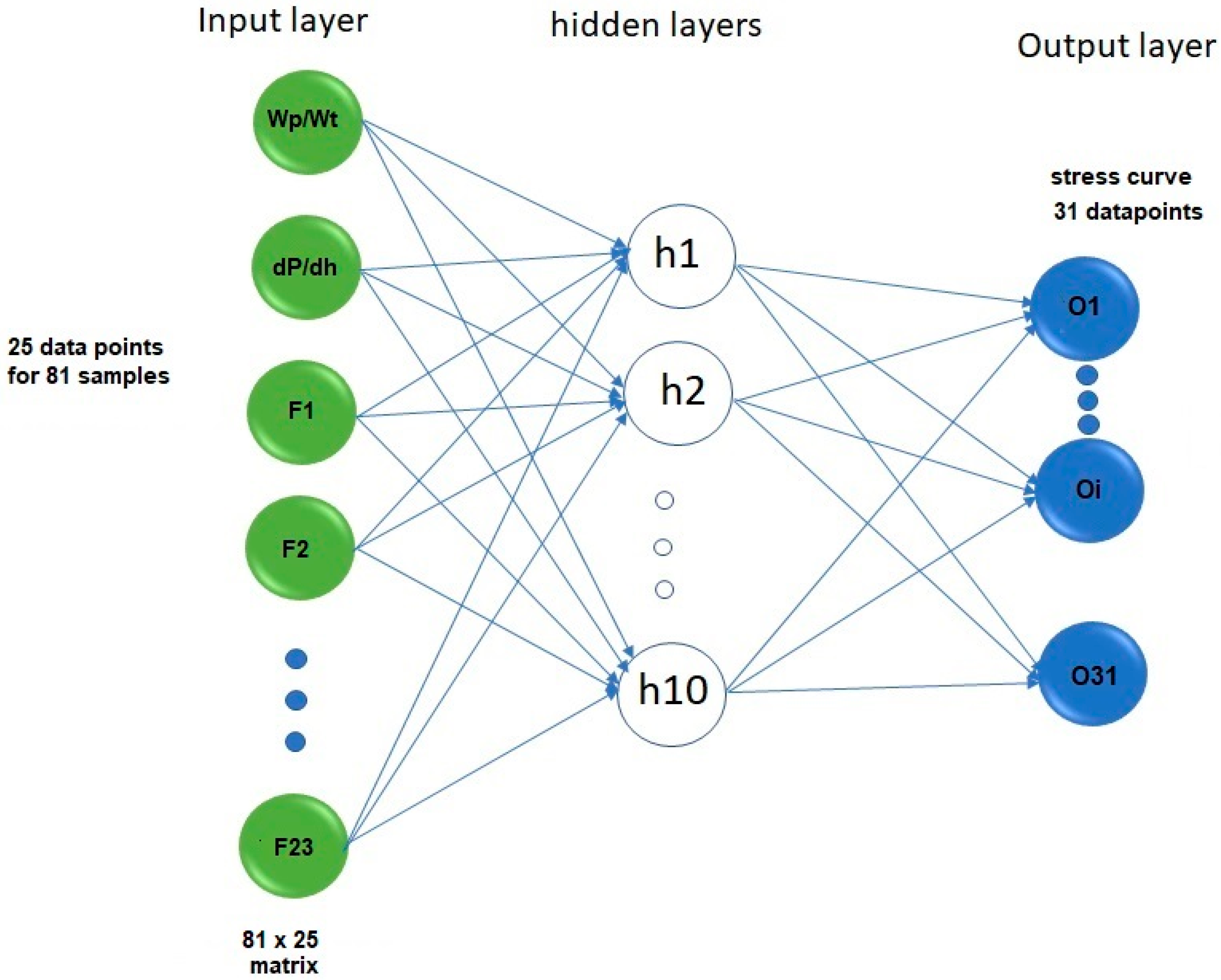
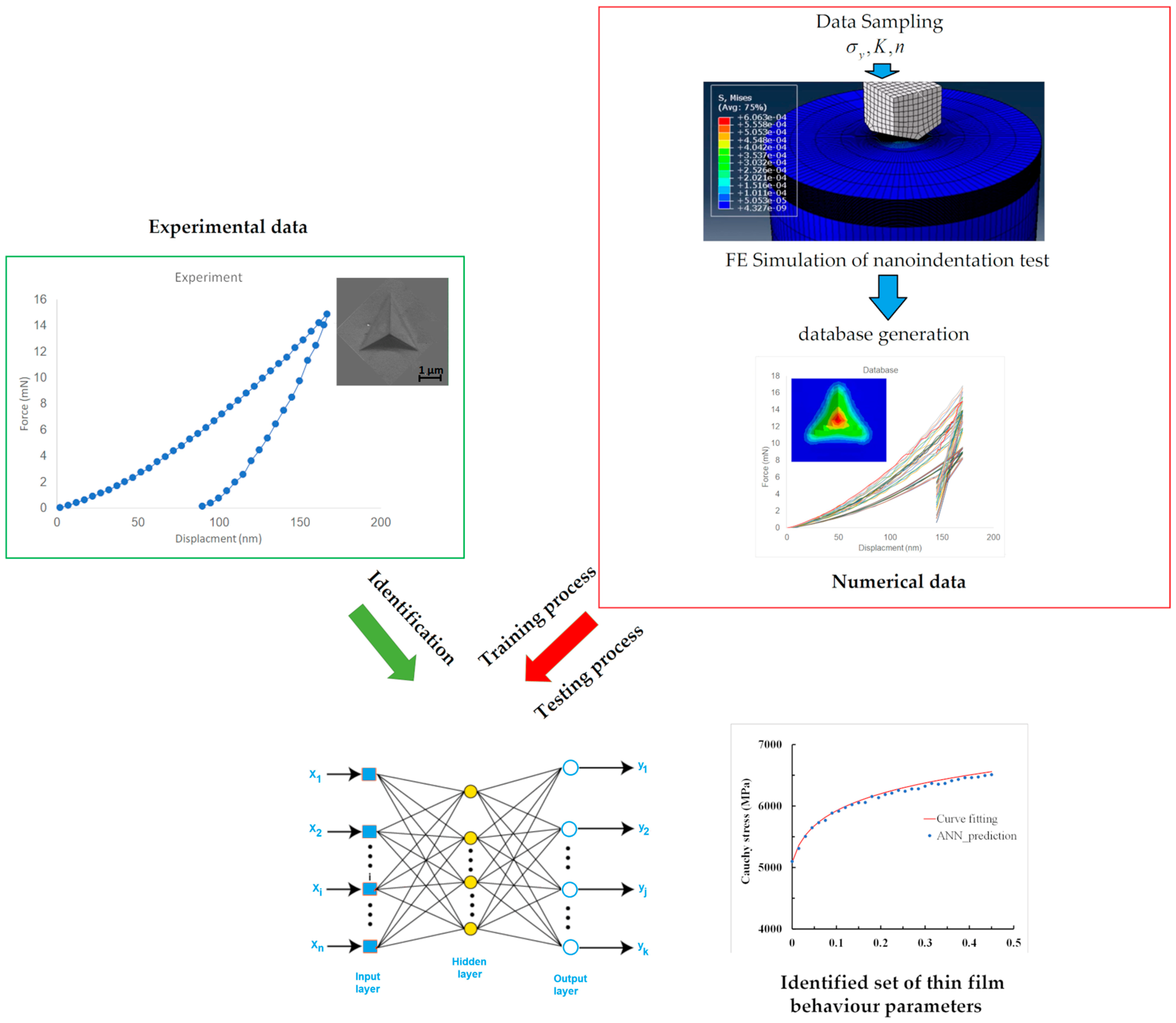
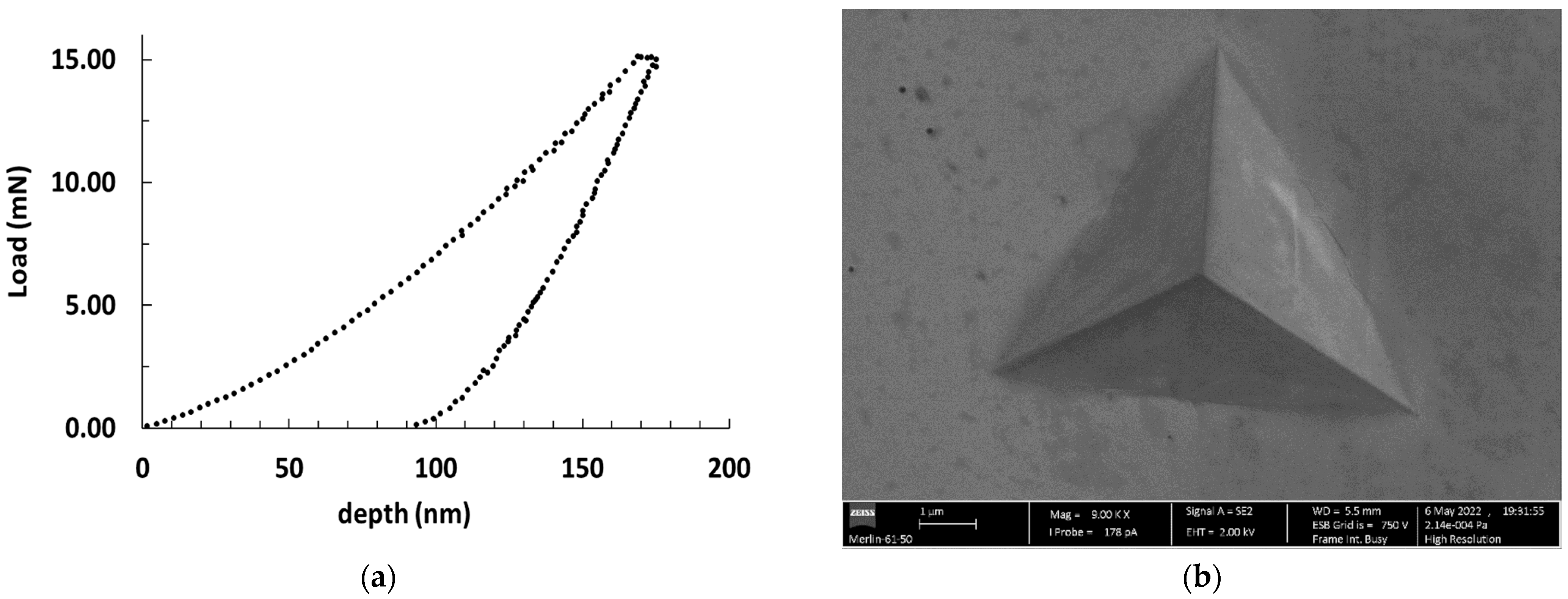
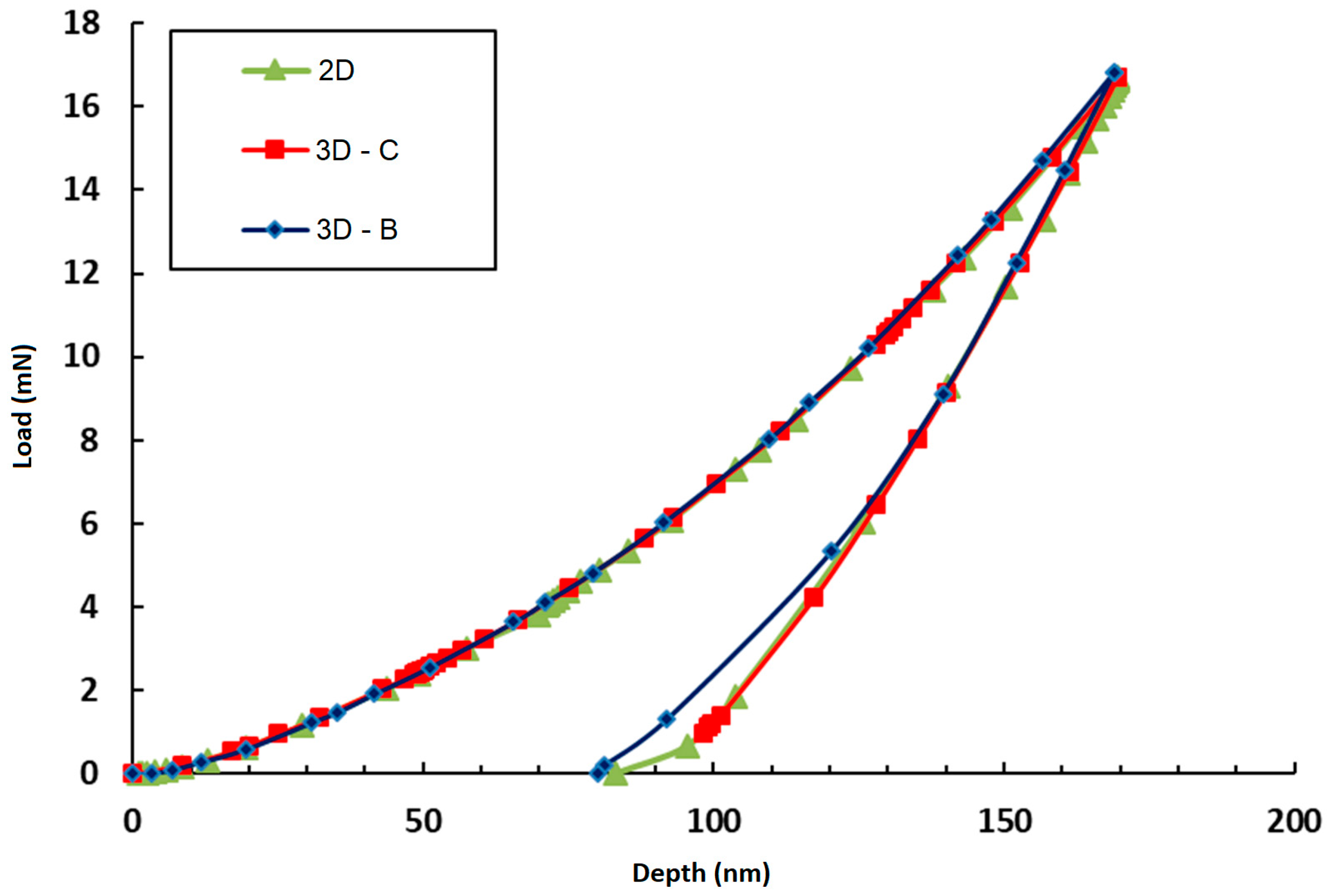

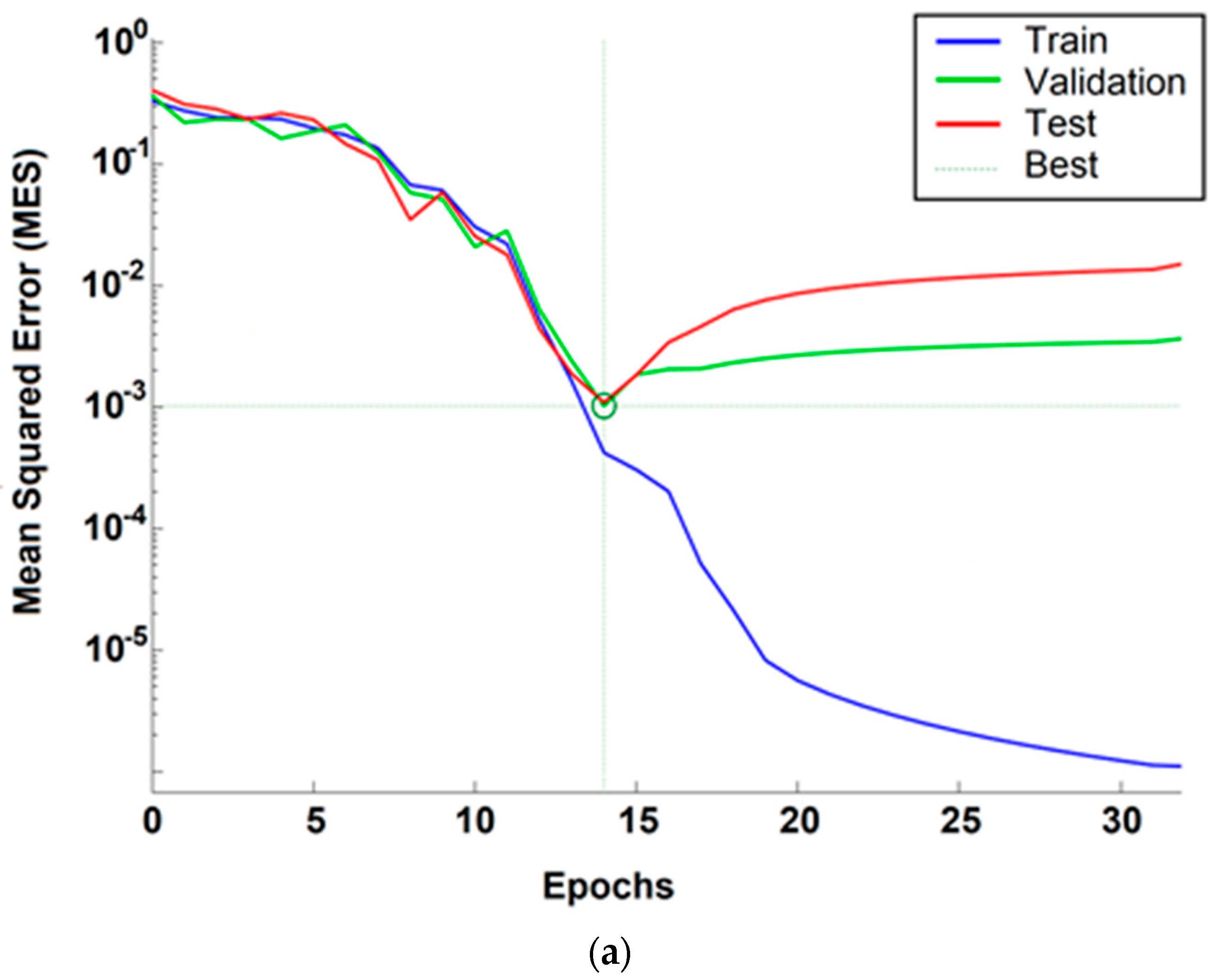
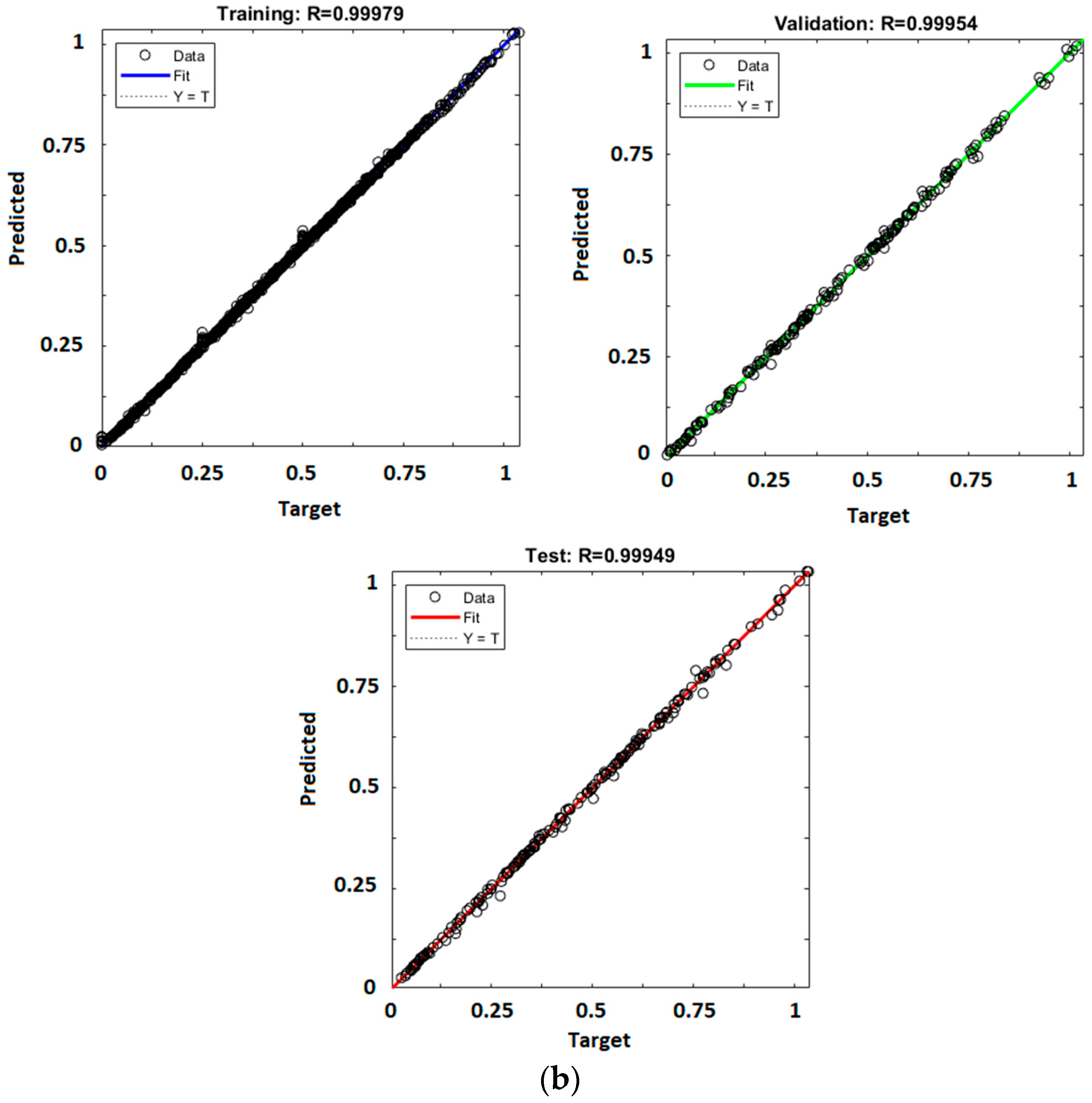
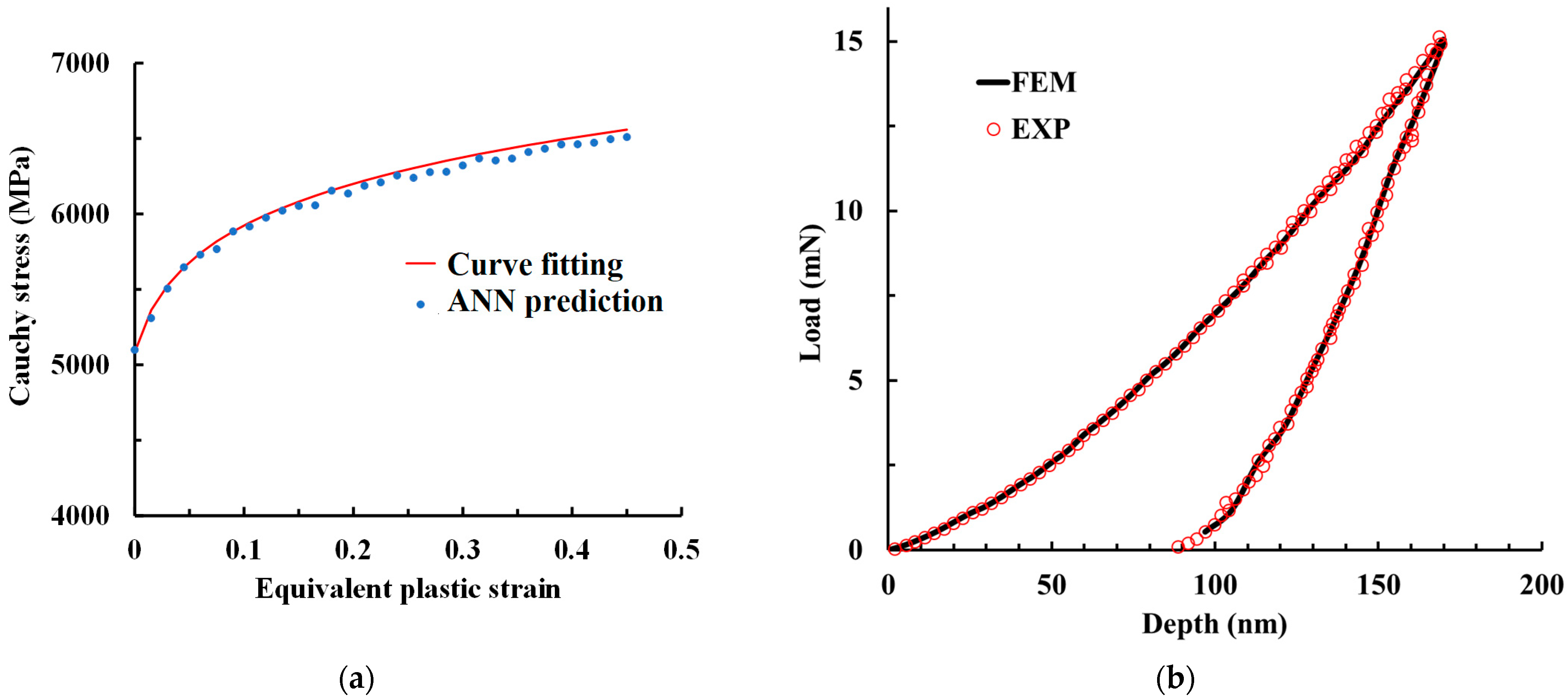
| Test No. | σy (GPa) | E (GPa) | n (-) |
|---|---|---|---|
| 1 | 5 | 150 | 0.02 |
| 2 | 5 | 150 | 0.05 |
| 3 | 5 | 150 | 0.09 |
| 4 | 5 | 300 | 0.02 |
| 5 | 5 | 300 | 0.05 |
| … | … | … | … |
| 80 | 6 | 450 | 0.09 |
| 81 | 7 | 450 | 0.09 |
| Feature | Feed-Forward Network |
|---|---|
| Learning method | Supervised learning |
| Training method | Levenberg–Marquart backpropagation |
| Activation function | Log sigmoid (Logsig) Linear (Purelin) |
| Number of layers | 3 layers: (input, hidden, output) ([81 × 25], 10, [1 × 31]) |
| Number of hidden neurons | 10 |
| Learning rate | 0.01 |
| Performance metric | Mean squared error: (MSE) |
| Material | Hardness (GPa) | E (GPa) | Max Load (mN) | Max Depth (nm) | Degree of the Elastic Recovery % |
|---|---|---|---|---|---|
| GaN | 19.5 ± 0.5 | 356 ± 8 | 15.09 ± 0.02 | 170.06 ± 1.65 | 28 ± 9 |
| Sapphire substrate [47] | 27.5 ± 2 | 420.6 ± 20 | - | - | - |
| Yield Stress σy (MPa) | Young’s Modulus E (GPa) | Power Law Exponent n (-) |
|---|---|---|
| 5105.7 | 365.4 | 0.073 |
Disclaimer/Publisher’s Note: The statements, opinions and data contained in all publications are solely those of the individual author(s) and contributor(s) and not of MDPI and/or the editor(s). MDPI and/or the editor(s) disclaim responsibility for any injury to people or property resulting from any ideas, methods, instructions or products referred to in the content. |
© 2024 by the authors. Licensee MDPI, Basel, Switzerland. This article is an open access article distributed under the terms and conditions of the Creative Commons Attribution (CC BY) license (https://creativecommons.org/licenses/by/4.0/).
Share and Cite
Khalfallah, A.; Khalfallah, A.; Benzarti, Z. Identification of Elastoplastic Constitutive Model of GaN Thin Films Using Instrumented Nanoindentation and Machine Learning Technique. Coatings 2024, 14, 683. https://doi.org/10.3390/coatings14060683
Khalfallah A, Khalfallah A, Benzarti Z. Identification of Elastoplastic Constitutive Model of GaN Thin Films Using Instrumented Nanoindentation and Machine Learning Technique. Coatings. 2024; 14(6):683. https://doi.org/10.3390/coatings14060683
Chicago/Turabian StyleKhalfallah, Ali, Amine Khalfallah, and Zohra Benzarti. 2024. "Identification of Elastoplastic Constitutive Model of GaN Thin Films Using Instrumented Nanoindentation and Machine Learning Technique" Coatings 14, no. 6: 683. https://doi.org/10.3390/coatings14060683
APA StyleKhalfallah, A., Khalfallah, A., & Benzarti, Z. (2024). Identification of Elastoplastic Constitutive Model of GaN Thin Films Using Instrumented Nanoindentation and Machine Learning Technique. Coatings, 14(6), 683. https://doi.org/10.3390/coatings14060683








